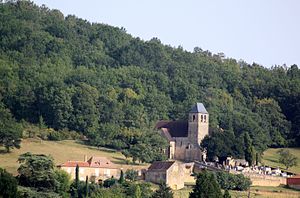Marnac
| Marnac | ||
|---|---|---|
|
|
||
| region | Nouvelle-Aquitaine | |
| Department | Dordogne | |
| Arrondissement | Sarlat-la-Canéda | |
| Canton | Vallée Dordogne | |
| Community association | Vallée de la Dordogne and Forêt Bessède | |
| Coordinates | 44 ° 50 ′ N , 1 ° 2 ′ E | |
| height | 45-260 m | |
| surface | 7.92 km 2 | |
| Residents | 188 (January 1, 2017) | |
| Population density | 24 inhabitants / km 2 | |
| Post Code | 24220 | |
| INSEE code | 24254 | |
 Marnac - town view |
||
Marnac ( Occitan : identical) is a place and a municipality ( commune ) in southwestern France with 188 inhabitants (as of January 1, 2017) in the old cultural landscape of the Périgord in the Dordogne department in the northeast of the Aquitaine region .
location
The place Marnac is on a slight hill above the south bank of the Dordogne in the Périgord Noir at an altitude of about 140 m above sea level. d. M. and about 26 kilometers (driving distance) southwest of Sarlat-la-Canéda .
Population development
| year | 1968 | 1975 | 1982 | 1990 | 1999 | 2006 | 2012 |
| Residents | 196 | 161 | 175 | 185 | 192 | 198 | 187 |
In the 19th century, the population of the community was always between about 300 and 500 people. The phylloxera crisis in viticulture and the loss of jobs due to the mechanization of agriculture led to a continuous population decline that reached its lowest point in the 1970s.
economy
Up to the present day agriculture plays the largest role in the economic life of the municipality; In the 17th and 18th centuries there were numerous mills on the Céou River. However, the viticulture practiced here was completely given up after the phylloxera crisis . Tobacco and corn are also on the decline - instead, forests, fields and pastures, but also walnut , chestnut and fruit trees dominate the region. Also, foie gras and truffles are among the best regional cuisine. Some vacant houses are rented out as holiday apartments ( gîtes ).
history
The first written mention of the place under the name Marnacum comes from the year 1365, but a women's priory, dependent on the Benedictine abbey of Le Bugue , existed above today's place.
Attractions
- The parish church of Saint-Sulpice dates from the 14th century; its architecture has late medieval features. The renaissance portal makes a ramshackle impression; the single nave nave is vaulted with ribs .
- Located outside the place Château de Bétou ( 44 ° 50 '28 " N , 1 ° 1' 24" O ) has its origins in the 14th and 15th centuries; however, it was extensively restored in the 19th century and is now privately owned.

